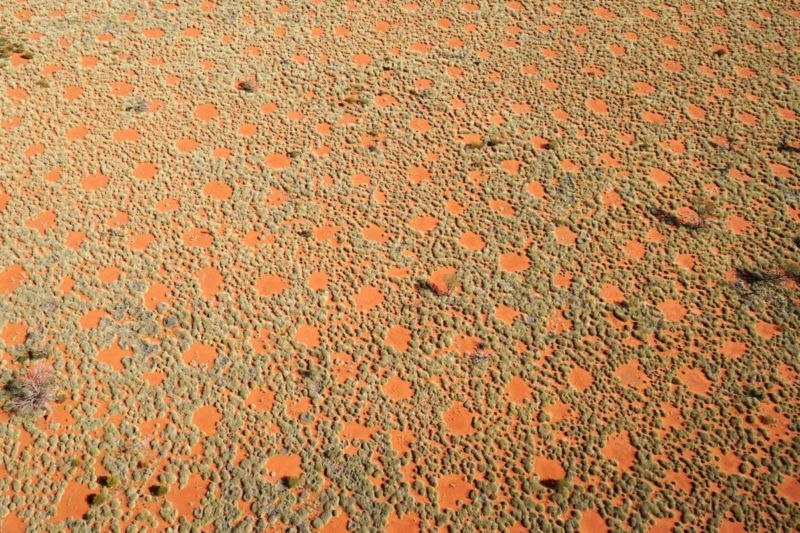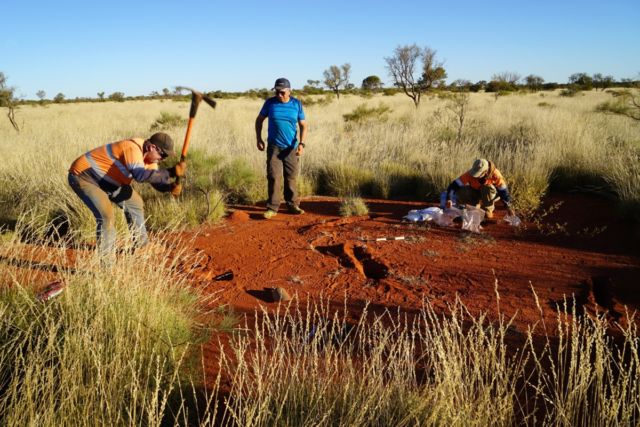
Himba bushmen in the Namibian grasslands have passed down legends about the region's mysterious "fairy circles"—bare, reddish-hued circular patches dotted along the 1200-mile long swath of land. They can be as large as several feet in diameter. Dubbed "footprints of the gods," it's often said they are the work of the Himba deity Mukuru, or an underground dragon whose poisonous breath kills anything growing inside those circles.
Scientists have their own ideas, and over the years two different hypotheses have emerged about how the circles form. One theory attributes the phenomenon to a particular species of termite (Psammmotermes allocerus), whose burrowing damages plant roots, resulting in extra rainwater seeping into the sandy soil before the plants can suck it up—giving the termites a handy water trap as a resource. As a result, the plants die back in a circle from the site of an insect nest. The circles expand in diameter during droughts because the termites must venture further out for food. The other hypothesis holds that the circles are a kind of self-organized spatial growth pattern arising as plants compete for scarce water and soil nutrients.
Two new papers, one published in the journal Ecosphere and the other in the Journal of Arid Environments, add yet another dimension to the ongoing debate. The authors argue that—at least in northwestern Australia, where fairy circles were first observed in 2014—termite activity may be present at such formations, so there's some correlation in the data. But termites aren't causing the fairy circles. The authors attribute the circles' emergence to natural weather-related processes like heavy rainfall, extreme heat, and evaporation. These events deplete the soil of nutrients, forcing plants to compete for scarcer resources to survive.
"No destructive mechanisms, such as those from termites, are necessary for the formation of the distinct fairy circle patterns."
"Overall, our study shows that termite constructions can occur in the area of the fairy circles, but the partial local correlation between termites and fairy circles has no causal relationship," said co-author Stephan Getzin of the University of Gottingen in Germany. "So no destructive mechanisms, such as those from termites, are necessary for the formation of the distinct fairy circle patterns; hydrological plant-soil interactions alone are sufficient.”
Roots of a controversy
Biologist Walter Tschinkel of Florida State University concluded in 2012 that the circles had an average lifespan of 41 years, based on his analysis of satellite images over many decades. He thought termites were the most likely explanation but found no evidence to support his hypothesis. The following year, ecologist Norbert Juergens of the University of Hamburg reported evidence of an especially clandestine nocturnal species of sand termite (Psammmotermes allocerus) that could be the culprits, based on his sampling of around 1,200 fairy circles from his many trips to Africa.
That didn't quite convince others, in part because the termite hypothesis doesn't account for why the fairy circles eventually disappear. That same year, Michael Cramer of the University of Capetown—who describes himself as a "plant ecophysiologist"—published a paper arguing that the circles are the result of self-organized spatial patterning, typical of how plants compete in resource-scarce environments like the arid grasslands of Namibia.

Cramer built on prior computer modeling work, combining Google Earth images of the fairy circles in Namibia with soil samples from the region to produce a new computational model. That model predicted the distribution of the circles with 93 percent accuracy, and Cramer found that variations in rainfall were the strongest contributing factor in their model. After fairy circles were also discovered in Australia, he argued in a 2016 paper that this was further evidence for the "competition for scant resources" hypothesis.
So who is right? Maybe both, according to a 2017 paper that tried to reconcile these two competing hypotheses with a new computer model combining elements of both. Co-author Corina Tarina, an evolutionary biologist at Princeton University, and several colleagues first ran simulations to mimic the impact of underground termite activity on desert grasses, particularly the effect of neighboring colonies of a similar size that came up against one another. This process results in a kind of stalemate, establishing a border between their territories.
The team next built a computer model that simulated the warring underground termites as well as the natural competition that arises between desert greenery. As the grass grows, there is more competition for precious resources. The long roots must draw water from further away, depriving plants in those more distant areas of water, for instance. Adding that plant competition to the model produced the most similar patterns to the fairy circles. To confirm their findings, the group traveled to Namibia to photograph the fairy circles firsthand and found an exact match, although they didn't claim to have an explanation for how every fairy circle forms.
-
Google Earth image showing oval-shaped mega fairy circles forming a chain-like structure along a drainage line in Namibia.Google Earth
-
The Namibian chain of mega-fairy circles as seen on the ground.Stephan Getzin
Now, an international team of scientists from Germany, Australia, and Israel have weighed in with the results of their study of fairy circles in northwestern Australia, near an old mining town called Newman. The team dug over 150 holes in almost 50 fairy circles in the region to collect and analyze soil samples, specifically to test the termite hypothesis. They also used drones to map larger areas of the continent to compare the gaps in vegetation typically caused by harvester termites in the region, with the fairy circles that sometimes form.
"The vegetation gaps caused by harvester termites are only about half the size of the fairy circles and much less ordered," said Getzin of their findings. "And in most cases, we didn't even find any hard subterranean termitaria that elsewhere in Australia prevent the growth of grasses." But they did find high soil compaction and clay content in the circles, evidence for the contribution of heavy rainfall, extreme heat, and evaporation to their formation.
Or maybe it's just subterranean dragons with bad breath.
DOI: Ecosphere, 2019. 10.1002/ecs2.2620 (About DOIs).
DOI: Journal of Arid Environments, 2019. 10.1016/j.jaridenv.2019.01.017 (About DOIs).
reader comments
25